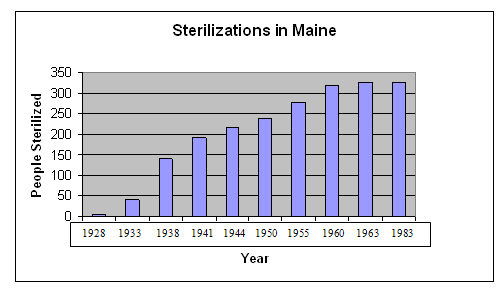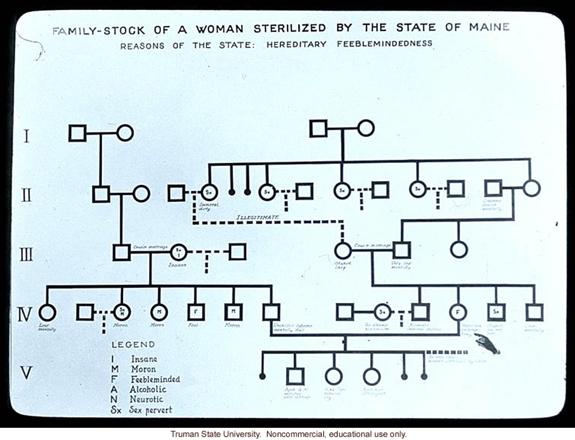Maine
A total of 326 individuals were
sterilized in
The
Assistant Attorney General of Maine was quoted saying that many more
operations had been performed than had been reported but that they
"shall go by the records" in 1936 (Reilly, p. 162).
Period When Sterilizations Occurred
Sterilizations in
Eugenics courses were taught at the University of
Maine from about 1913 until about 1930 (Glenna et al, p. 288).
Temporal Pattern of Sterilizations

After relatively few sterilization up to 1932, the period of 1933 to 1940 marked a peak period, during which time 149 people were sterilized. After that, the number of sterilizations declined, although there was a two-year spike of 43 sterilizations in 1954/1955 (see Paul, p. 370). During the peak period in the 1930s, the sterilization rate per 100,000 residents per year was about 2, whereas the same rate could be observed in the short peak period in the 1950s.
Passage of Law
In Maine, if a court regarded written material
regarding contraception as “obscene, vulgar, and indecent” then there were laws
they could use to illegalize it (Laughlin, p. 347). Maine law mentioned nothing
about a jury to determine the question of insanity (Laughlin, p. 351).
Marriage Restrictions
Prior to the 1930’s Maine’s marriage laws prevented
the marriage of “idiots”, “imbeciles”, and “feebleminded” persons, but did not
define each of the categories (Schuler, p. 305). Maine failed to address the
validity of the marriage of a person of unsound mind, and assumed marriages to
be void based on that person’s inability to comprehend the nature of the
contract they were making (Schuler, pp. 312, 313). Moreover, abortion was a key
issue included in Maine’s eugenics laws. Maine allowed abortions in situations
where it would save the mother’s life. However, Maine acknowledged abortion as
a crime throughout pregnancy, but as the state of pregnancy varied so did the
penalty (Caron, p. 24).
Groups Identified in the Law
Process of Law
It appears that core elements of the 1925 law remained intact after the
1931 law had passed, in so far as, Julius Paul notes, a voluntary
sterilization request could come from those identified in the 1925 law
(or relatives or legal guardian) and was extramural and voluntary, and
it involved state authorities only in so far as a committee of three
doctors at
Groups Targeted/Victimized
The group victimized most was females deemed feeble-minded and who were residents of a state-run institution.
 (Digital picture origin:
(Digital picture origin:
“Feeder Institutions” and Institutions where Sterilizations were Performed
 (Cumberland
Hall at
(Cumberland
Hall at
189 sterilizations were preformed at the
The Pineland Center located in New Gloucester, Maine, was established in 1908. After it closed in 1996 it was bought by the Libra Foundation who have since renovated the property and purchased additional adjacent property to expand the center. The Foundation hopes to create a community of non-profit and for-profit businesses, organizations, and services by leasing space in the buildings. The Pineland Center, otherwise known as Pineland Farms, Inc., is currently a fully operational farm; it offers public educational programming, outdoor recreation, and a world-class equestrian center. The website for Pineland Farms, Inc., mentions nothing about its history of sterilizations and eugenics (Pineland Farms).
Though
no sterilizations are known
to have occurred in these places, they are important in recognizing how
the
“unfit” were social outcasts and segregated from normal society.
However, 137 sterilizations remain unaccounted for
(Paul, p. 370).
Augusta State hospital, formerly the
Maine Insane Hospital, opened in 1834 for the care and treatment of people with
mental and nervous disorders (Dunnack, p.271). In 1907 the hospital was
modified to be suitable to house people that were criminally insane as well (Dunnack,
p.272). At one point the rated capacity of the institution was 942. However, on
January 21, 1920 there was a total of 1,121 patients; 573 men and 548 women
(Dunnack p. 272).
Bangor state Hospital, formerly the
Eastern Maine Insane Hospital, opened in July 1901 in response to a greater
need of space for people with mental disorders. This hospital received patients
from Penobscot, Hancock, Washington, Aroostook, and Piscataquis. Between 1907
and 1910 the hospital underwent many expansions, including adding two
additional wings to house male and female patients (Dunnack, p. 273). All other patients from different regions of
Maine were sent to the Augusta State Hospital (Dunnack, p.274). The capacity of
the hospital was rated at 600. However, on January 21, 1920, there was a total
of 684 patients; 355 men and 329 women (Dunnack, pp. 273, 274).
There were also two state schools,
one for boys and one for girls. The boys’ school was established as a detention
center for boys between the ages of eight and sixteen who needed restraint and
correction. However, the school did not admit subjects considered to be
feebleminded, insane, deaf, dumb, or blind (Dunnack, p. 283). The girls’ school,
named the Maine Industrial School for Girls and in 1915 was renamed The State
School for Girls, was not a “house of correction” but was designed for girls
between the ages of six and twenty-one who were in danger of becoming “outcasts
of society”. Subjects were admitted into The State School for Girls if they
were deemed to be leading an “idle or vicious life” by the municipal officers,
or three respectable citizens of the town where they live. Once committed, the
girl became a ward of the state, and could only be discharged by a vote of the
trustees (Dunnack, pp. 286, 287).
Maine also established specific schools for people who were deaf and blind respectively (Dunnack, pp. 291, 300).
Although no sterilizations seem to have occurred at
Maine’s Jackson Labs, the institution’s founder, C.C. Little, promoted medical
eugenics. His research was usually conducted on mice. It does not appear that
he ever used wards of the state for experiments (Engel).
Opposition
Bibliography
Caron, Simone M. 2008. Who Chooses? American Reproductive History Since 1830. Gainsville: University Press of Florida
Dunnack, Henry E. 1920. The Maine Book. Augusta, ME. Librarian of Maine State Library.
Engel, Randy. “Eugenics and the History of Bar Harbor,
Maine’s Jackson Labs/ How the Inbred Lab Mouse Helps Reprogram the Human
Genome.” Alex Constantine’s Anti-Fascist
Encyclopedia. Available at http://www.antifascistencyclopedia.com/allposts/eugenics-and-the-history-of-bar-harbor-maines-jackson-labshow-the-inbred-lab-mouse-helps-reprogram-the-human-genome
Landman, J. H. 1932. Human Sterilization: The History of the Sexual Sterilization Movement. New York: MacMillan.
Laughlin, Harry H. 1922. Eugenical Sterilization in the United States. Chicago: Psychopathic Laboratory of the Municipal Court of Chicago.
Leland L. Glenna, Margaret A.
Gollnick and Stephen S. Jones. 2007. “Eugenic Opportunity Structures: Teaching
Genetic Engineering at US Land-Grant Universities since 1911.” Social Studies of Science 37, 2: 281-96.
Paul, Julius. 1965. "'Three Generations of Imbeciles Are Enough': State Eugenic Sterilization Laws in American Thought and Practice." Washington, D.C.: Walter Reed Army Institute of Research.
Pineland Farms. "Pineland's History." Available at <http://www.pinelandfarms.org/visitors/history.htm>.
Reilly, Philip R. 1987. “Involuntary
Sterilization in the United States: A Surgical Solution.” The Quarterly Review of Biology. 62, 2: 153-70.
Schuler, Ruth V. 1940. “Some Aspects of Eugenic
Marriage Legislation in the United States.” The Social Service Review. 14, 2: 301-316.
Vintage Maine Images. “Cumberland Hall,